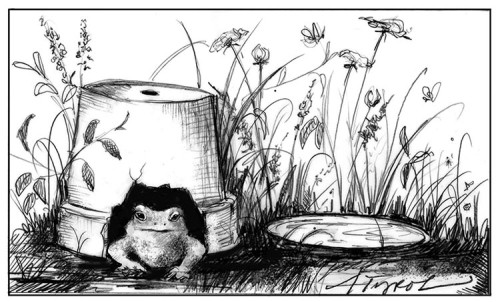
Encountering a snake in the garden causes many people to shriek or even panic. Yet snakes and another often unloved creature, the American toad, are among the most effective forms of pest control. If you tolerate these herpetological visitors – or better yet, encourage their presence – you’ll be less likely to share your garden with ravenous bugs, or bottles of pesticide.
There are several snakes that make themselves at home in local gardens. The common garter snake is identifiable by the three yellow stripes running along the back. In my garden, this snake often suns itself between rows of vegetables, absorbing heat while digesting slugs, caterpillars, sowbugs, and other garden pests. Larger garter snakes (they can grow about three feet long) also eat meadow voles, which will otherwise wreak havoc on roots, tubers, and bark.
My favorite snakes are among the most docile encountered in a garden: the smooth green snake and ring-necked snake. The grass-hued scales of the green snake blend in well. Almost three fourths of its diet consists of insects, including grasshoppers, hornworms, and other crop-munching caterpillars. The ring-necked snake, named for its golden collar, stalks similar prey, but it does so under the stars. With a back the color of night, and its bright yellow belly pressed to the earth, it’s well camouflaged for nocturnal hunting.
In contrast, the milk snake strikes when threatened. Although non-venomous, the milk snake’s attitude, size (it grows to three feet long) and rows of alternating reddish-brown splotches, which resemble the patterning of a copperhead or timber rattlesnake, have earned an undeserved reputation and the misnomer of “adder.” In fact, it is harmless to all but the mice, voles, other small mammals and other snakes that comprise up to 70 percent of its diet.
You can attract snakes to your garden by providing habitat: loose rock piles, old tree stumps, brush piles, prone boards, a stack of wood, and unkempt corner swales. And since pesticides can sicken and kill reptiles and amphibians, maintaining a chemical-free garden safeguards these natural predators.
Snakes consume far more garden pests than beneficial species. Unfortunately, larger snakes do prey on that holy grail of herpetological pest control: the American toad, which can devour three times its own weight in bugs per day. Toads can eat 50 to 100 insects and other prey each night, or 10,000 in a growing season, including slugs, earwigs, Japanese beetles, cutworms, grasshoppers, sow bugs, snails, cucumber beetles, grubs, and tent caterpillars. More than 80 percent of their diet consists of harmful garden pests.
In the children’s story The Wind in the Willows, Toad lives in an historic estate with all of the modern conveniences. In real life, toads require only a cool, moist environment. They frequently take cover under mulch or hide in the undergrowth of a feral garden corner. To avoid the desiccating heat of the sun, they’re most active during the evening and at night (particularly wet nights). If toads like their habitat, they’ll remain for a year or more and simply dig a deeper burrow to overwinter.
It’s easy to construct your own Toad Hall. Place a terra cotta pot upside down in a shady nook with a thin layer of leaves for bedding. Dig a tunnel about three inches wide and deep so toads can creep in under the rim of the pot. The clay pot absorbs rainwater, which evaporates and cools the interior.
Toads are also drawn to water, so you might build a tiny pond to complement your toad home. Set a birdbath into the earth so that the lip is level with the ground, or dig an eight- to twelve-inch deep depression that measures three to four feet across and is partly shaded. Since toads can’t climb out of a pond if the edge is steep, make sure one side slopes down gently. Line the hole with plastic. Create a small patch of gravel on part of the bottom and spread a thin layer of mud over the rest where dragonflies and damselflies can lay their eggs; the nymphs will hatch into adults that eat lots of garden pests (and in the meantime, will prey on any mosquito larvae). Don’t add fish to the pond or they’ll eat everything else.
It only takes a little encouragement to attract beneficial herps to your garden. Even if your relationship with snakes doesn’t progress beyond mutual tolerance, toads do tend to grow on you.


Discussion *